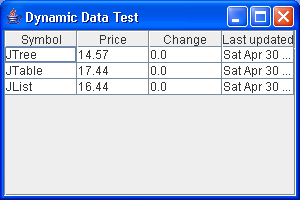Custom model, POJO and JTable

/*
Java Swing, 2nd Edition
By Marc Loy, Robert Eckstein, Dave Wood, James Elliott, Brian Cole
ISBN: 0-596-00408-7
Publisher: O'Reilly
*/
// MarketTable.java
//An application that display stock market data in a JTable. The table
//uses the MarketDataModel class for its model. MYOSM should be running
//to make the data dynamic.
//
import java.awt.BorderLayout;
import java.util.Date;
import java.util.Random;
import javax.swing.JFrame;
import javax.swing.JLabel;
import javax.swing.JScrollPane;
import javax.swing.JTable;
import javax.swing.table.AbstractTableModel;
public class MarketTable extends JFrame {
public MarketTable() {
super("Dynamic Data Test");
setSize(300, 200);
setDefaultCloseOperation(EXIT_ON_CLOSE);
// Set up our table model with a 5-second polling delay
MarketDataModel mdm = new MarketDataModel(5);
// Pick which stocks we want to watch . . .
mdm.setStocks(new int[] { 0, 1, 2 });
// And pop up the table
JTable jt = new JTable(mdm);
JScrollPane jsp = new JScrollPane(jt);
getContentPane().add(jsp, BorderLayout.CENTER);
}
public static void main(String args[]) {
MarketTable mt = new MarketTable();
mt.setVisible(true);
}
}
//MarketDataModel.java
//A custom table model for use with the MYOSM enviornment.
//
class MarketDataModel extends AbstractTableModel implements Runnable {
Thread runner;
MYOSM market;
int delay;
public MarketDataModel(int initialDelay) {
market = new MYOSM();
delay = initialDelay * 1000;
Thread runner = new Thread(this);
runner.start();
}
Stock[] stocks = new Stock[0];
int[] stockIndices = new int[0];
String[] headers = { "Symbol", "Price", "Change", "Last updated" };
public int getRowCount() {
return stocks.length;
}
public int getColumnCount() {
return headers.length;
}
public String getColumnName(int c) {
return headers[c];
}
public Object getValueAt(int r, int c) {
switch (c) {
case 0:
return stocks[r].symbol;
case 1:
return new Double(stocks[r].price);
case 2:
return new Double(stocks[r].delta);
case 3:
return stocks[r].lastUpdate;
}
throw new IllegalArgumentException("Bad cell (" + r + ", " + c + ")");
}
public void setDelay(int seconds) {
delay = seconds * 1000;
}
public void setStocks(int[] indices) {
stockIndices = indices;
updateStocks();
fireTableDataChanged();
}
public void updateStocks() {
stocks = new Stock[stockIndices.length];
for (int i = 0; i < stocks.length; i++) {
stocks[i] = market.getQuote(stockIndices[i]);
}
}
public void run() {
while (true) {
// Blind update . . . we could check for real deltas if necessary
updateStocks();
// We know there are no new columns, so don't fire a data change,
// only
// fire a row update . . . this keeps the table from flashing
fireTableRowsUpdated(0, stocks.length - 1);
try {
Thread.sleep(delay);
} catch (InterruptedException ie) {
}
}
}
}
//Stock.java
//A simple aggregate class for storing stock market information on a single
//stock (symbol, price, etc.).
//
class Stock {
String symbol;
double price;
double delta;
Date lastUpdate;
public Stock(String s, double p) {
symbol = s;
price = p;
lastUpdate = new Date();
}
public void update(double d) {
delta = d;
price += delta;
}
public void print() {
System.out.println(symbol + ": " + price + " (" + delta
+ ") last updated " + lastUpdate);
}
}
//MYOSM.java
//Make Your Own Stock Market: A simple stock market simulator that contains a
//few stocks and their current prices (and deltas). It randomly adjusts the
//prices on stocks to give a dynamic feel to the data.
//
class MYOSM extends JFrame implements Runnable {
Stock[] market = { new Stock("JTree", 14.57), new Stock("JTable", 17.44),
new Stock("JList", 16.44), new Stock("JButton", 7.21),
new Stock("JComponent", 27.40) };
boolean monitor;
Random rg = new Random();
Thread runner;
public MYOSM() {
// Not meant to be shown as a real frame
super("Thread only version . . .");
runner = new Thread(this);
runner.start();
}
// This version creates a real frame so that you can see how the typical
// stocks get updated. It's not meant to be used with other programs,
// but rather as a debugging tool to make sure the market runs ok.
public MYOSM(boolean monitorOn) {
super("Stock Market Monitor");
setSize(400, 100);
setDefaultCloseOperation(EXIT_ON_CLOSE);
monitor = monitorOn;
getContentPane().add(
new JLabel("Trading is active. "
+ "Close this window to close the market."),
BorderLayout.CENTER);
runner = new Thread(this);
runner.start();
}
// Here's the heart of our stock market. In an infinite loop, just pick a
// random stock and update its price. To make the program interesting, we'll
// update a price every second.
public void run() {
while (true) {
int whichStock = Math.abs(rg.nextInt()) % market.length;
double delta = rg.nextDouble() - 0.4;
market[whichStock].update(delta);
if (monitor) {
market[whichStock].print();
}
try {
Thread.sleep(1000);
} catch (InterruptedException ie) {
}
}
}
public Stock getQuote(int index) {
return market[index];
}
// This method returns the list of all the symbols in the market table
public String[] getSymbols() {
String[] symbols = new String[market.length];
for (int i = 0; i < market.length; i++) {
symbols[i] = market[i].symbol;
}
return symbols;
}
public static void main(String args[]) {
MYOSM myMarket = new MYOSM(args.length > 0);
myMarket.setVisible(true);
}
}
Related examples in the same category